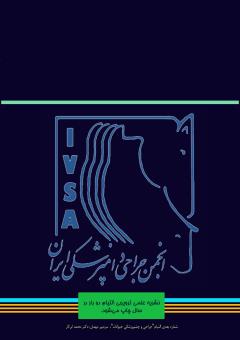Principles of oral and injectable fluid therapy in equine colic
Subject Areas :Fattah Iranmanesh 1 , Fatemeh Heydari 2 , Ehsanollah Sakhaee 3
1 -
2 -
3 -
Keywords: Fluid therapy, Horse, Colic,
Abstract :
Fluid therapy is one of the most important parts of the treatment protocol for horses with colic. Fluid therapy methods include oral and intravenous administration. Although intravenous fluid intake is the most basic form of fluid therapy in horses with colic, prudent use of oral fluid therapy can be used as an adjunct or alternative treatment.
1. Southwood LL. Fehr J. Practical guide to equine colic. John Wiley & Sons, 2012.
2. León LS, Davie A, Hodgson D, Rose R. The effects of tonicity, glucose concentration and temperature of an oral rehydration solution on its absorption and elimination. Equine Vet J 1995; 27: 140-146.
3. Alexander FBD. A radiological study of the digestive tract of the foal. Quarterly J Exp Physiol Cogn Med Sci 1951; 36: 213-217.
4. Argenzio R, Lowe J, Pickard D, Stevens C. Digesta passage and water exchange in the equine large intestine. Am J Physiol 1974; 226: 1035-1042.
5. Monreal L, Navarro M, Armengou L, et al. Enteral fluid therapy in 108 horses with large colon impactions and dorsal displacements. Vet Rec 2010; 166: 259.
6. .Hallowell G. Retrospective study assessing efficacy of treatment of large colonic impactions. Equine Vet J 2008; 40: 411-413.
7. Lopes MA, White II NA, Donaldson L, et al. Effects of enteral and intravenous fluid therapy, magnesium sulfate, and sodium sulfate on colonic contents and feces in horses. Am J Vet Res 2004; 65: 695-704.
8. Marlin D, Scott C, Mills P, Louwes H, Vaarten J. Rehydration following exercise: effects of administration of water versus an isotonic oral rehydration solution (ORS). Vet J 1998; 156: 41-49.
9. Butudom P, Schott H, Davis M, et al. Drinking salt water enhances rehydration in horses dehydrated by frusemide administration and endurance exercise. Equine Vet J 2002; 34: 513-518.
10. Lopes M, Moura GS., Jose F. Treatment of large colon impaction with enteral fluid therapy. In Proceedings of the American Association of Equine Practitioners, 1999; 99-102.
11. Lopes M, Walker B, White II NW, Ward D. Treatments to promote colonic hydration: enteral fluid therapy versus intravenous fluid therapy and magnesium sulphate. Equine Vet J 2002; 34: 505-509.
12. Henninger R. W. and Horst J. Magnesium toxicosis in two horses. J Am Vet Med Assoc 1997; 211: 82-85.
13. Dabareiner R. and White N. Large colon impaction in horses: 147 cases (1985-1991). J Am Vet Med Assoc 1995; 206: 679-685.
14. Hotchkiss R, Karl I. Calcium: a regulator of the inflammatory response in endotoxemia and sepsis. New horizons (Baltimore, Md.) 1996; 4: 58-71.
15. Nicoud IB, Knox CD, Jones CM, et al. 2-APB protects against liver ischemia-reperfusion injury by reducing cellular and mitochondrial calcium uptake. Am J Physiol Gastrointest Liver Physiol 2007; 293: G623-G630.
16. Kim JE, Jeon JP, No HC, et al. The effects of magnesium pretreatment on reperfusion injury during living donor liver transplantation. Korean J Anesthesiol 2011; 60: 408-415.
17. Lee CY, Jan WC, Tsai PS, Huang CJ. Magnesium sulfate mitigates acute lung injury in endotoxemia rats. J Trauma Acute Care Surg 2011; 70: 1177-1185.
18. Batista MB, Bravin AC, Lopes LM, et al. Pressor response to fluid resuscitation in endotoxic shock: Involvement of vasopressin. Crit Care Med 2009; 37: 2968-2972.
19. Kreimeier U, Thiel M, Peter K, Messmer K. Small-volume hyperosmolar resuscitation. Acta Anaesthesiol Scand Supplementum 1996; 111: 302-306.
20. Pantaleon LG. Fluid therapy in equine patients: small-volume fluid resuscitation. Compendium (Yardley, PA), 2010; 32: E1-6, quiz E7.
21. Radhakrishnan RS, Shah SK, Lance SH, et al. Hypertonic saline alters hydraulic conductivity and up-regulates mucosal/submucosal aquaporin 4 in resuscitation-induced intestinal edema. Crit Care Med 2009; 37: 2946.
22. Pascual JL, Khwaja KA, Chaudhury P, Christou NV. Hypertonic saline and the microcirculation. J Trauma Acute Care Surg 2003; 54: S133-S140.
23. Oliveira R, Weingartner R, Ribas E, et al. Acute haemodynamic effects of a hypertonic saline/dextran solution in stable patients with severe sepsis. Intensive Care Med 2002; 28: 1574-1581.
24. Fielding C, Magdesian KA. comparison of hypertonic (7.2%) and isotonic (0.9%) saline for fluid resuscitation in horses: a randomized, double‐blinded, clinical trial. J Vet Intern Med 2011; 25: 1138-1143.
25. Magdesian KG. Colloid replacement in the ICU. Clin Tech Equine Pract 2003; 2: 130-137.
26. Oliveira RP, Velasco I, Soriano FG, Friedman G. Clinical review: Hypertonic saline resuscitation in sepsis. Crit Care 2002; 6: 418.
27. Marik PE, Iglesias J. Would the colloid detractors please sit down! Crit Care Med 2000; 28: 2652.
28. Nielsen VG, Tan S, Brix AEet al. Hextend [registered sign] (hetastarch solution) decreases multiple organ injury and xanthine oxidase release after hepatoenteric ischemia-reperfusion in rabbits. Crit Care Med 1997; 25: 1565-1574.
29. Boldt J, Muller M, Heesen M, et al. Influence of different volume therapies and pentoxifylline infusion on circulating soluble adhesion molecules in critically ill patients. Crit Care Med 1996; 24: 385-391.
30. Shields C, Wang J, Winter D, et al. Hypertonic saline enhances host response to bacterial challenge by augmenting neutrophil intracellular Superoxide formation. Ir J Med Sci 2002; 171: 10-10.
31. Silverstein DC, Aldrich J, Haskins SC, et al. Assessment of changes in blood volume in response to resuscitative fluid administration in dogs. J Vet Emerg Crit Care 2005; 15: 185-192.


